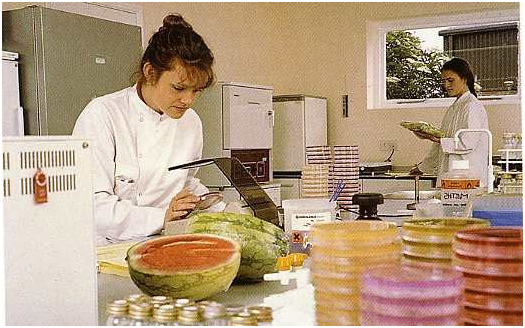Extrinsic factors of food spoilage are the non-substrate factors that affect the spoilage of foods and food products and which are not innately found in the foods. These factors are the environmental factors that are implicated in food spoilage occurrences. They are different from the intrinsic factors that cause food spoilage. The extrinsic factors are those factors that interact with the microbial activities that normally go on in food or food products. Typical examples of extrinsic factors that affect microbial growth in foods are temperature, relative humidity, gases and the amount or number and type of microorganisms present in the food.
The gases in this case include oxygen and carbondioxide which favour the growth of particular microbes. Temperature and humidity are amongst the most critical extrinsic factors that affect microbial growth in foods; and when foods/food products are improperly preserved in terms of the temperature and humidity level they are kept, such food products are likely to undergo spoilage due to microbial activity in them.
When food or food products are stored in conditions of high humidity and low temperature levels, such foods or food products are bound to undergo spoilage due to the intense microbial activity going on in it. Frosted foods or food products (i.e. foods stored in the refrigerator and in a frosted state) can last more than foods stored in defrosted states in the refrigerator. Nevertheless, some psychrotolerant microorganisms (i.e. microorganisms that can withstand low temperatures or cold conditions) can thrive efficiently at a very low temperature as obtainable in the refrigerator (e.g. 3oC).
Most perishable fresh foods may undergo thawing and lose their physical storage during storage especially when they are not stored at temperatures below freezing temperature (e.g. –20oC). Storage of perishable foods like meat, vegetables and fruits at –20oC over a long period of time is possible but expensive and thus they are not routinely used for food storage. However, when grains for example are not properly stored, moulds can rapidly grow on them thus causing their spoilage. Claviceps purpura, an ascomycete is a typical example of a fungus that infects grains to cause the disease condition known as ergotism.
Ergotism is the toxic condition or disease that is caused by the consumption of grains infected with ergot or ascomycete. Ergot is the dried sclerotium of C. purpurea. Psychotic delusions, gangrene, abortion, convulsions and nervous spasms are symptoms associated with ergotism in both man and animals. Extrinsic factors play critical roles in food spoilage and thus foods should be properly stored after processing in order to contain and minimize their contamination by microbes that initiate food spoilage.
References
Bushell M.E (1998). Application of the principles of industrial microbiology to biotechnology (ed. Wiseman, A.) Chapman and Hall, New York.
Byong H. Lee (2015). Fundamentals of Food Biotechnology. Second edition. Wiley-Blackwell, New Jersey, United States.
Clark D.P and Pazdernik N (2010). Biotechnology. First edition. Elsevier Science and Technology Books, Amsterdam, Netherlands.
Farida A.A (2012). Dairy Microbiology. First edition. Random Publications. New Delhi, India.
Frazier W.C, Westhoff D.C and Vanitha N.M (2014). Food Microbiology. Fifth edition. McGraw-Hill Education (India) Private Limited, New Delhi, India.
Guidebook for the preparation of HACCP plans (1999). Washington, DC, United States Department of Agriculture Food Safety and Inspection Service. Accessed on 20th February, 2015 from: http://www.fsis.usda.gov
Hayes P.R, Forsythe S.J (1999). Food Hygiene, Microbiology and HACCP. 3rd edition. Elsevier Science, London.
Hussaini Anthony Makun (2013). Mycotoxin and food safety in developing countries. InTech Publishers, Rijeka, Croatia. Pp. 77-100.
Jay J.M (2005). Modern Food Microbiology. Fourth edition. Chapman and Hall Inc, New York, USA.
Lightfoot N.F and Maier E.A (1998). Microbiological Analysis of Food and Water. Guidelines for Quality Assurance. Elsevier, Amsterdam.
Nduka Okafor (2007). Modern industrial microbiology and biotechnology. First edition. Science Publishers, New Hampshire, USA.
Roberts D and Greenwood M (2003). Practical Food Microbiology. Third edition. Blackwell publishing Inc, USA.
Discover more from #1 Microbiology Resource Hub
Subscribe to get the latest posts to your email.



